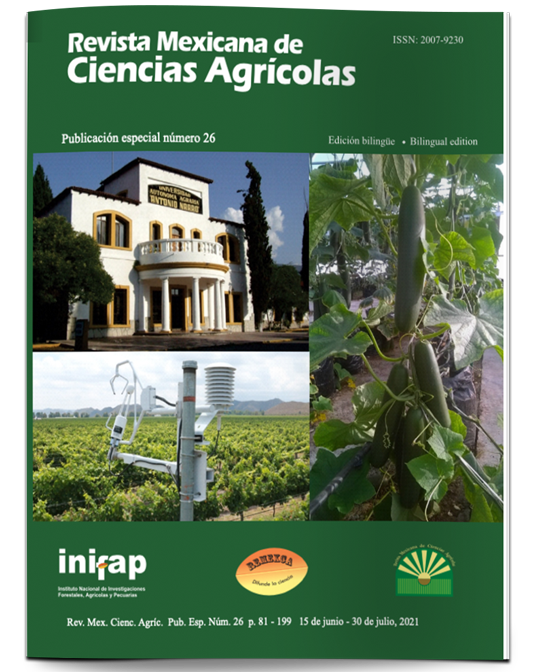Bactericera cockerelli vector of Candidatus Liberibacter solanacearum, morphometrics and haplotypes in populations from Mexico
DOI:
https://doi.org/10.29312/remexca.v0i26.2939Keywords:
Ca. L. solanacearum, eggplant, haplotype, potato psyllidAbstract
Bactericera cockerelli is a pest of economic importance in Solanaceae in Mexico, due to the yellowings that causes in crops, as well as the transmission of Candidatus Liberibacter solanacearum. Genetic variants of this insect are described, which are related to its ability to serve as a vector. In Mexico, the distribution of B. cockerelli is very wide and information about its morphological and genetic characteristics is lacking. The objective of this research was to characterize B. cockerelli morphologically and genetically and detect the presence of Ca. L. solanacearum in populations of B. cockerelli from Solanaceae-producing areas in Mexico. For which 35 locations from 13 states were sampled, on chili, tomato, eggplant and potato crops, under different production systems. The variables body length (LC), abdomen length (LAB), and abdomen width (AAB) were measured in insects of each population, the presence of Ca. L. solanacearum was detected in the 13 sampled states, where males had the highest percentage of positive insects. The presence of Ca. L. solanacearum was not influenced by the host or production system, but by the presence of B. cockerelli.
Downloads
Downloads
Published
How to Cite
Issue
Section
License
Copyright (c) 2021 Revista Mexicana de Ciencias Agrícolas

This work is licensed under a Creative Commons Attribution-NonCommercial 4.0 International License.
The authors who publish in Revista Mexicana de Ciencias Agrícolas accept the following conditions:
In accordance with copyright laws, Revista Mexicana de Ciencias Agrícolas recognizes and respects the authors’ moral right and ownership of property rights which will be transferred to the journal for dissemination in open access. Invariably, all the authors have to sign a letter of transfer of property rights and of originality of the article to Instituto Nacional de Investigaciones Forestales, Agrícolas y Pecuarias (INIFAP) [National Institute of Forestry, Agricultural and Livestock Research]. The author(s) must pay a fee for the reception of articles before proceeding to editorial review.
All the texts published by Revista Mexicana de Ciencias Agrícolas —with no exception— are distributed under a Creative Commons License Attribution-NonCommercial 4.0 International (CC BY-NC 4.0), which allows third parties to use the publication as long as the work’s authorship and its first publication in this journal are mentioned.
The author(s) can enter into independent and additional contractual agreements for the nonexclusive distribution of the version of the article published in Revista Mexicana de Ciencias Agrícolas (for example include it into an institutional repository or publish it in a book) as long as it is clearly and explicitly indicated that the work was published for the first time in Revista Mexicana de Ciencias Agrícolas.
For all the above, the authors shall send the Letter-transfer of Property Rights for the first publication duly filled in and signed by the author(s). This form must be sent as a PDF file to: revista_atm@yahoo.com.mx; cienciasagricola@inifap.gob.mx; remexca2017@gmail.
This work is licensed under a Creative Commons Attribution-Noncommercial 4.0 International license.



